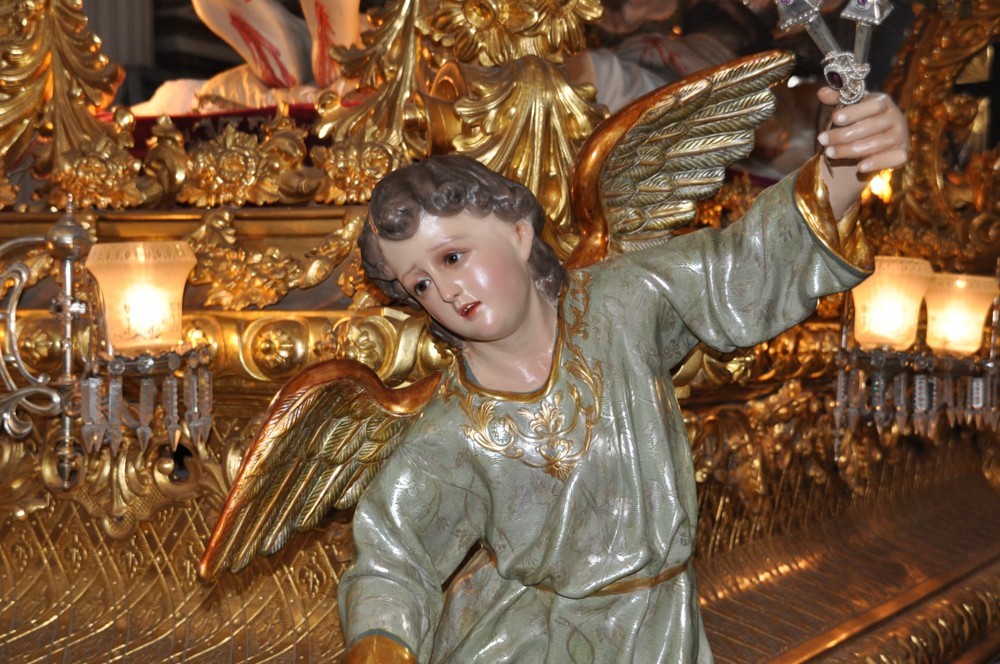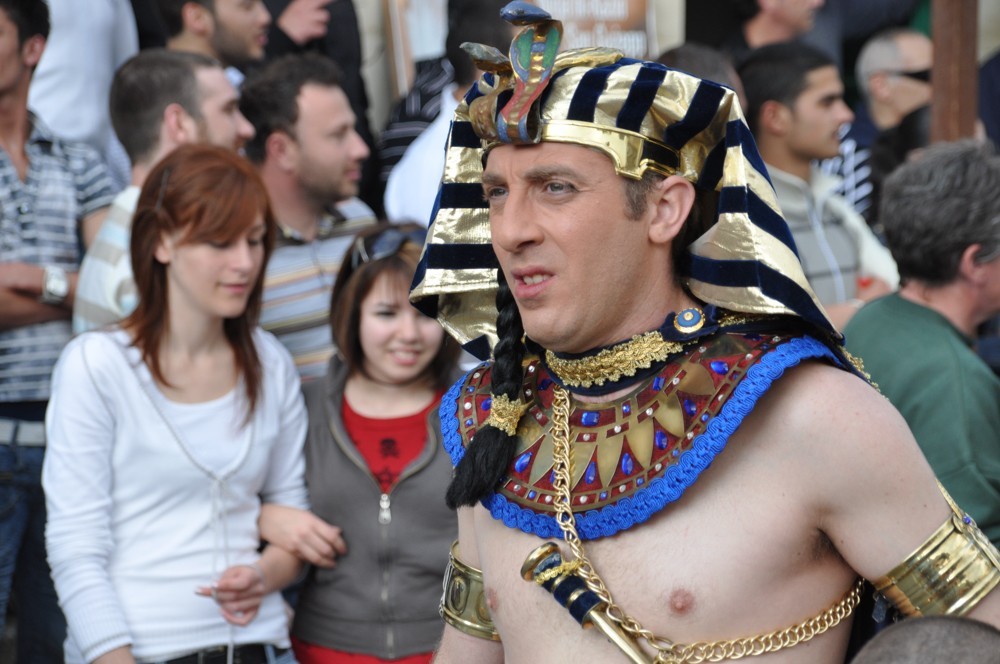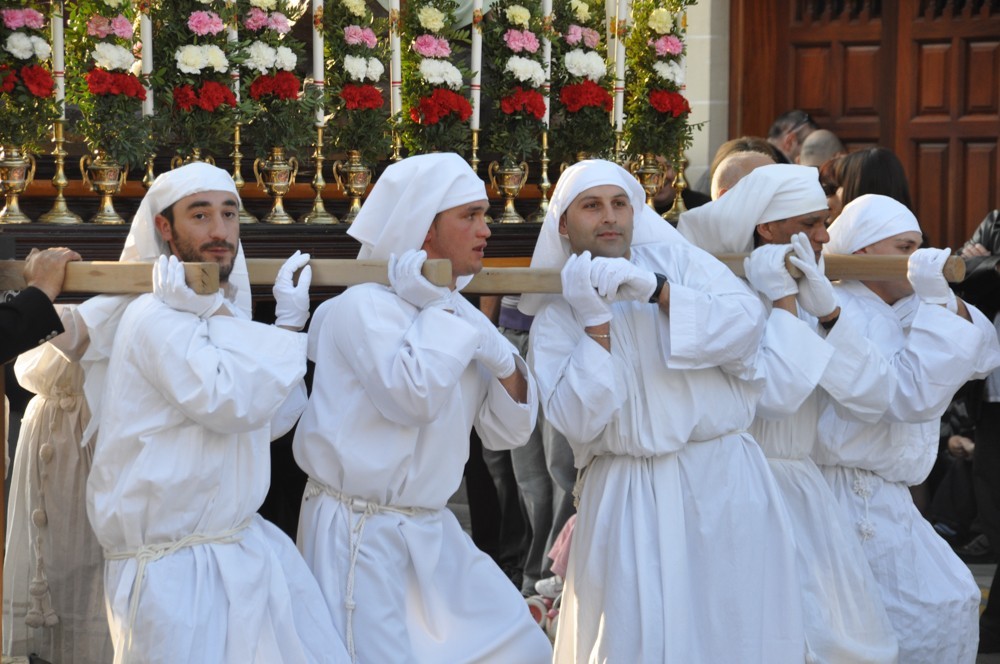The culture in Malta and its Good Friday celebration are the reasons I had come to this tiny speck in the Mediterranean. Despite being only 17 miles by 9 miles, the island has more than 365 churches—the majority of the country’s population is Catholic and it’s said that four out of five Maltese regularly attend Mass. A lapsed Catholic myself, I had been drawn here by the prospect of a spectacle. In the process, I had found myself humbled by the strong faith in evidence here—not just in grand, symbolic expressions but woven in the fabric of day-to-day life.
Arriving in Zebbug on Good Friday, I found the culture of Malta pulsating with anticipation. Throngs of people milled about to the strains of rousing music blaring through loudspeakers. Bright-eyed toddlers sat atop their fathers’ shoulders; gray-haired women leaned on their elbows at their windows; extended families filled wrought-iron balconies; teenage boys with baseball caps askew chatted up young women in leather jackets and Jackie O sunglasses; and middle-aged men stood off in the shadows with small cups of something strong.
Read: Want to hear all about the delicious food in Malta? A Sinizza may be your favorite!
A Dramatic and Powerful Procession
A vendor in the tree-lined plaza did a brisk business selling plump, over-sized pretzels and heart-shaped pastries painted with frosting. A crowd spilled from the door of a social club onto the sidewalk, where rows of folding chairs were filled to capacity. Officious-looking men in suits looked at their watches and paced inside space marked off with yellow police tape.
And then, finally, the first of a long line of elaborately-costumed participants appeared and the parade began to wind its way through the streets. All of us who had been eagerly awaiting this moment were not disappointed. Lavish headdresses, prancing horses, flowing robes, regal bearings and proud faces made for one of the most dramatic and powerful processions I had ever witnessed.
Yet the purple pageantry and palpable hum of excitement here was tinged with a somber patina. Most of those gathered to watch the procession were dressed in black. Scanning the faces of the multitude assembled, I saw that their countenances were reverential rather than delighted, and deeply moved more than amused; some had tears in their eyes.
Maltese Tradition Has Symbolic Significance
Joe Pisani, one of several friends I made while on Malta, explained the symbolic significance of both the occasion and the emotion:
“This is a unique exhibition which has been a Maltese tradition for many years. In such processions, they mingle characters and events of when Jesus was among the Jews and his exploits during his 33 years on earth. The Good Friday procession depicts the last day of Christ and symbolizes Jesus and the apostles being greeted by the crowd when he entered Jerusalem on a donkey. They carry palms and olive tree branches to symbolize Jesus’ prayers in the garden of Gethsemane, and when one of the apostles Judas was bribed to identify Jesus, and from there he was taken for interrogation to the high priests and the Roman governor Pontius Pilate and after torture was crucified."
“All these events are depicted in each statue that is carried in the procession by volunteers, who pay the church to carry them. There will be other people in chains and carrying heavy loads as penitence or to achieve a blessing from God, as they may have problems in life or sickness in the family. The other procession is held on Easter Sunday and commemorates the resurrection of Christ and normally it is one statue followed by high clergy and people.”
Read: Interested in learning more about the world's unique celebrations? Check out the Mardi Gras Indian culture in New Orleans!
Displays of Faith in Vittoriosa, One of Malta's 'Three Cities'
Earlier in the day I had wandered the streets of Vittoriosa, one of Malta’s “Three Cities.” While actually small towns, these communities adorning promontories that reach into the island’s Grand Harbor are of strong historical significance. Inside the Church of St. Lawrence, which dates to the 16th century, I beheld a phenomenon that seemed extraordinary to me.
Amidst elaborate displays of religious art, the faithful paying their respects were not only engaging in solitary prayer and contemplation but communing with each other. Clusters of people congregated together across several rows of pews, engaged in animated conversation. A young couple proudly showed off a gurgling baby and elderly matrons leaning on canes checked on each other’s health. Old friends hugged and a popular father made the rounds, with two sons in tow that were his spitting image.
I later learned that another strong tradition among the Maltese is visiting seven different churches on Good Friday, which denotes the seven sorrows of the Virgin Mary during the crucifixion of Jesus.
Christine Saidnawey, a Maltese friend living in the Boston area, told me that with plenty of churches within close proximity, families typically walk to the seven churches and recite the Rosary on the way. She also observed that sometimes families will make a day of it and drive to different churches in the villages and towns throughout Malta.
Read: Learn about the now endangered, 15th century Cyprus tradition of Lefkara lace making.
Culture in Malta is Warm, Generous, and Spiritual
As I traversed the island, I had seen signs displayed at churches proclaiming “Wirja,” which in Malti means display or manifestation. In Vittoriosa, I decided to investigate. Passing through a thick red velvet curtain, I entered a dark, candle-lit church hall with an exhibit of the Last Supper that spanned two large adjoining rooms.
I followed a father and his two youngsters as the long line of viewers wound past the display of figures of saints and apostles—often these representations are made from colored rice and salt. I found I was more engaged with watching the young man explaining the tableau to his wide-eyed children than focused on appreciating the detailed and delicate folk artistry laid out before us. The father’s eyes met mine and we both smiled; when he turned back to his tots, I felt my eyes well up, moved by witnessing the transmission of faith from one generation to the next.
During my stay on Malta, I was consistently impressed by the warmth, generosity of spirit, and sense of community of its people. Despite having my own brand of spirituality, I appreciated being allowed to witness and participate in their demonstrations of faith. To forge such a connection, to be offered such an opportunity and open to receiving it, is a gift for which I am grateful.
Interested in learning about other Spiritual Practices around the world?
- Lafayette Cemetery No. 1 is Best Quirky Attraction in New Orleans
- Documenting Indian Art is Calling for Benoy K. Behl
- The Purpose of An Iconographer Explained by Renowned Icon Painter
- Celtic Priest on Spiritual Heritage and Traditions of Aran Islands
- Good Friday Tradition in Trapani Sicily Honors Faith and Heritage
- Interview with Mayan Shaman on Spiritual Practices and Philosophy
- San Juan Chamula Community Shares But Protects Traditions
- Curacao Synagogue is Oldest Jewish Congregation Site in North America
- Uncovering Chiapas Culture with the Hero of Chiapas, Mexico
- Best Things To Do in Ullapool Scenery, History and Crafts
- Culture in Malta Features Faith, Family and Pageantry
- Estonia’s Onion Route and The Old Believers
- Taize in Findhorn Eco Village Scotland
- What Inspires Spiritual Journeys? Explore the World’s Pilgrimages
- Easter Baskets in Slovenia At Tustanj Castle
- Eva Michaelsen on Walking Meditation and El Camino de Santiago
- What is Pilgrimage? Spiritual Seekers Share Experiences
- Icon Painter in Cyprus Honors Byzantine and Family Traditions
- Author Eric Weiner on “Man Seeks God”
Publisher and editor of People Are Culture (PAC). This article was created by original reporting that sourced expert commentary from local cultural standard-bearers. Those quoted provide cultural and historical context that is unique to their role in the community and to this article.














I am originally Maltese, live in the USA for 53 years, still love Malta and follow the Maltese news.